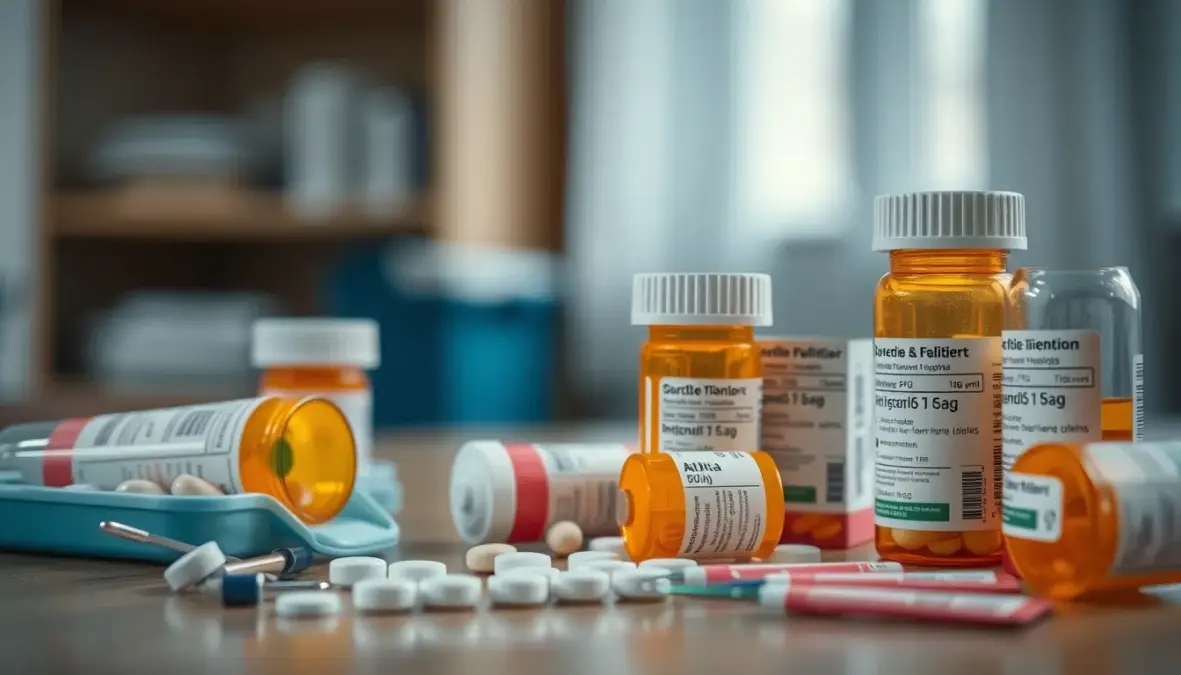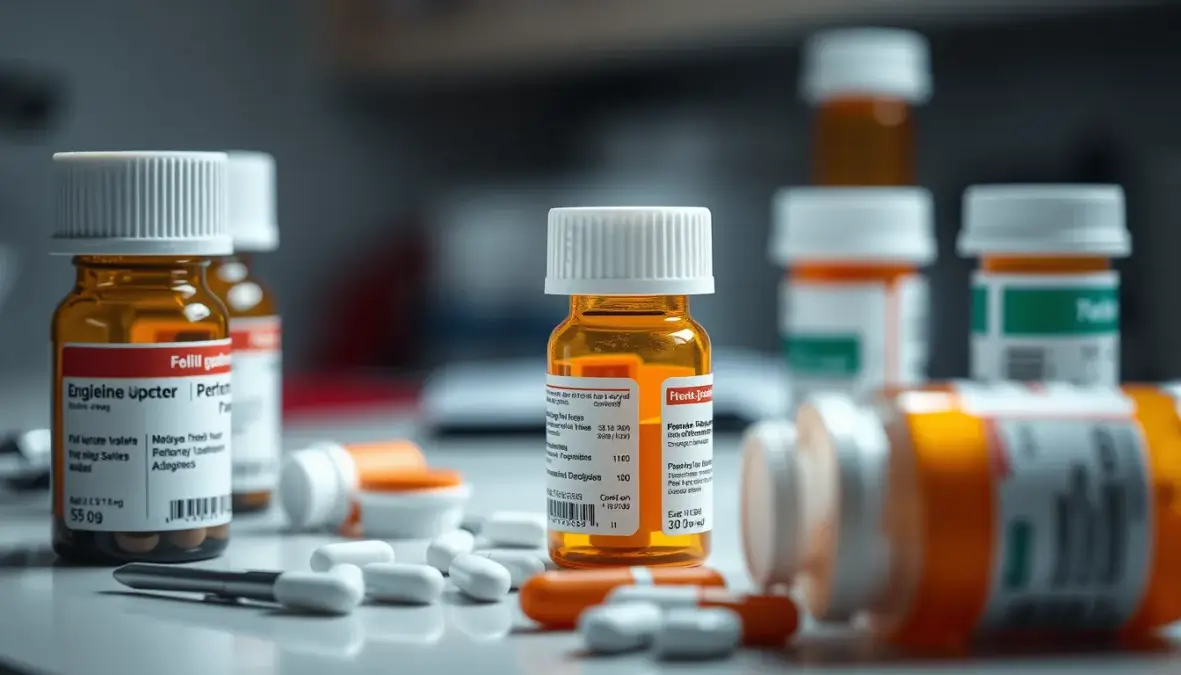Opioids are currently one of the most significant challenges in the field of pain management and drug withdrawal. Many people turn to various medications to cope with severe and often prolonged withdrawal symptoms. Subotica is one of the common solutions for treating opioid addiction, both due to its effectiveness and its relatively balanced side effect profile. In this article, we will take an in-depth look at the significance of Subotica in the detoxification process, understand how it affects the body, examine its advantages and disadvantages, and see how it fits into the overall treatment framework for people addicted to opioids.
However, it is essential to understand that the information presented here is not a substitute for medical advice. It is recommended to consult qualified professionals before starting any treatment, whether with Subutex or other medications in this field. Although Subutex allows you to reduce cravings and alleviate withdrawal symptoms, its use must be tailored to the individual patient according to their medical condition, addiction background, and any other factors that may affect the method of treatment.
Below, we will detail the main issues related to Subotex: its mode of action and chemical structure, the differences between Subotex and other drugs (such as Suboxone), how to use it (including questions such as "how to drink Subotex," "taking Subotex," and more), physiological and psychological effects, possible side effects, ways to deal with them, and current recommendations regarding discontinuing the drug and continuing treatment. Finally, we will also expand on common issues related to the process of recovery and withdrawal from opioids and provide a set of frequently asked questions (FAQ) that can help with an immediate answer.
What is Subutex and how does it work?
Subutex is a drug based on the active ingredient buprenorphine. Buprenorphine belongs to the family of partial agonist opioid drugs that bind to opioid receptors in the brain. However, it does not activate them as fully as strong opioids (such as heroin or morphine). This means that the opioid effect of buprenorphine is lower, and it may prevent some of the strong euphoric feelings that occur with the use of hard drugs. At the same time, it provides some relief from withdrawal symptoms without exacerbating cravings.
How does Subutex affect the body?
Subotex primarily affects the pain systems in the brain. It partially fills the receptors to which strong opioids bind. This allows for a decrease in cravings for a stronger drug, along with a reduction in withdrawal symptoms such as nausea, sweating, tremors, and irritability. Furthermore, Subotex also has a noticeable effect on the mental level: it provides a sense of relaxation and helps patients cope with the "satisfaction" that results from stopping the use of other opiate drugs. Therefore, in many cases, this treatment can be combined with psychological support from professionals.
Additionally, one of the important advantages of Subutex lies in its safety profile. At controlled medical doses, the risk of respiratory depression is lower than with full opioids. This is why doctors sometimes recommend Subutex as an option for detoxification treatment, as opposed to heroin or fentanyl, which present a very high risk of overdose.
Main uses of Subutex in opioid withdrawal
Treatment for withdrawal from heroin and strong painkillers
The most well-known use of Subutex is as a substitution treatment for people addicted to opioids such as heroin or strong painkillers (oxycodone, morphine, etc.). The treatment allows for gradual discontinuation of Subutex at a later stage, while significantly controlling withdrawal symptoms. This provides the patient with a safe and supervised setting that prevents relapse to the use of strong and illegal drugs.
Pain relief and reduced risk of abuse
Although best known as a drug for addiction, Subutex is also a specific pain reliever. However, it is now much less commonly used for pain relief than other opioid medications. This is due to its side effects, the need for careful dosing, and the fact that buprenorphine must be administered under medical supervision.
Preventing the need for other addictive opioids
The use of Subutex reduces dependence on stronger opioids, and therefore may prevent relapse to dangerous drug use. This allows for long-term treatment with less harm to the patient, both in terms of health and social aspects.
Subotica effect versus other drugs
Subutex is not the only medication that is helpful in treating opioid addiction. There are other products such as methadone and Suboxone, each of which has different benefits and side effect profiles. In many cases, a medical team will tailor the exact medication to the patient based on their medical history, the nature of the addiction, the psychological aspects, and the patient's living conditions.
Suboxone vs. Subutex
The main difference between the two drugs is that Suboxone contains a combination of buprenorphine and naloxone. Naloxone is an opioid blocker (antagonist) that is designed to prevent abuse, especially in the case of an attempt to inject the drug. Suboxone does not contain naloxone, so some people find it a more effective and "simpler" solution, without the fear of the effects associated with high-dose naloxone. On the other hand, Suboxone has a lower incidence of abuse.
What is better?
There is no clear answer to this question. The choice between subutex vs suboxone depends on the patient's medical condition, frequency of use, risk of "breaking" treatment and using unsupervisedly, and a variety of other factors. It is important to consult with a doctor who specializes in addictions before starting any treatment.
Subotica pills: dosages and administration form
Sublingual tablets are mainly available. Sublingual tablets are intended to be placed under the tongue until completely dissolved, rather than swallowed. Why is this method of administration chosen? The reason lies in the biology of the first pass through the liver. When buprenorphine passes through the digestive system, its bioavailability is low, while sublingual administration prevents partial breakdown in the digestive system and allows for more efficient absorption.
How to take Subutex?
In fact, the idea is not to swallow the pill but to let it dissolve under the tongue. Some people prefer to drink a little water after the pill dissolves, but it is recommended to avoid swallowing the pill itself because this reduces its effectiveness. Despite the phrase "how to drink Subotica", in reality it is a sublingual dissolution and not a swallowing. After dissolving, you can rinse your mouth with water to remove any aftertaste.
Step on Subotica
Some patients ask about "crushing Subotex," meaning crushing the pill and then consuming it in a different way. Generally, this is considered less advisable. Crushing the pill may damage the active ingredient, change the level of absorption, and cause unwanted effects. Therefore, doctors emphasize that you should stick to the treatment instructions and not change the form of administration on your own.
subutex 8mg
The dosage of Subutex can vary from patient to patient. One of the common forms is Subutex 8mg, which is considered a high dose and is mainly adapted to people who are in the initial stage of withdrawal when the physical dependence on opioids is at its peak. Other doses (2mg, 4mg, etc.) also exist, and the decision on the dosage is made by a doctor depending on the patient's condition. Treatment can last weeks or months, and sometimes even longer, until it is decided to gradually reduce the dose.
What are the possible side effects of Subutex?
Common side effects
-
Nausea and vomiting – Sometimes appear at the beginning of treatment, but usually decrease over time.
-
headache – A common side effect among buprenorphine users.
-
Dizziness and fatigue – May occur especially at the beginning of treatment or when changing dosage.
-
constipation – As with most opioid medications, gastrointestinal problems may occur.
Rarer side effects
-
Respiratory depression – Less common than other opioids but still possible in high doses or unsupervised use.
-
Allergic reactions – Itching, rash or swelling in various areas of the body.
-
Mood changes – Anxiety, nervousness, or feelings of depression. In these cases, it is advisable to consult your doctor.
The importance of medical follow-up
Subotica is considered a strong drug and carries a risk of misuse. Therefore, regular follow-up with a doctor is necessary. Periodic tests may include assessing the patient's mental state, blood tests if necessary, and changing the dosage if negative reactions or improvement in physical and mental condition are observed.
How to stop Subutex safely?
Stopping Subutex without medical supervision may create a "window" in which the patient will return to dependence on strong opioids or experience severe withdrawal symptoms. However, some patients wish to completely stop all medication use and cope without any external preparation.
-
Consultation with a doctor
The decision to stop taking Subutex should be made in full consultation with a medical professional, usually an addiction specialist or psychiatrist. It is important to consider the risks and consequences, and sometimes even involve a psychotherapist or social worker to build a comprehensive rehabilitation plan. -
Gradual dose reduction
Sudden discontinuation (cold turkey) of Subutex is generally not recommended. The reduction in dosage should occur gradually. This way, the body slowly adapts to the change, and the patient avoids acute withdrawal symptoms. In a controlled reduction, a doctor may reduce the dosage by 2mg or 1mg at each defined period, depending on the patient's condition and response. -
Psychological and environmental support
Alongside medication, it is essential that the patient has a supportive environment: family, friends and therapists. Sometimes it is recommended to combine participation in support groups or psychological treatments. This way, one copes not only with the physical dependence, but also with the emotional and behavioral difficulties of the detoxification process. -
Monitoring withdrawal symptoms
If severe symptoms occur, it is a good idea to inform your doctor quickly. In some cases, it may be necessary to adjust the reduction rate or incorporate additional supportive medications.
Combination therapy: why is it essential?
Subutex can help reduce physical withdrawal symptoms, but opioid addiction also has a very strong psychological component. That's why many therapists recommend a combination of treatment, which includes both medication and psychotherapy, support groups, or counseling. This treatment helps a person:
-
Understand the factors that led to addiction and identify negative thought patterns.
-
Acquire new coping skills with stressful situations or emotional distress.
-
Increase motivation to continue the rehabilitation process.
Patients who receive both Subutex pills and a comprehensive rehabilitation program have a higher chance of remaining in a stable condition over time.
How much does Subutex cost?
The cost of Subotica varies according to several parameters. Among other things, it depends on the type of medical insurance, whether the patient obtains the drug through health funds or privately, and the total duration of treatment. Subotica is usually included in the drug basket for patients who meet certain addiction criteria. Therefore, before starting treatment, it is recommended to inquire with the health fund or insurance company whether there is a subsidy and what the co-payment conditions are. In cases where there is no subsidy, the price may be quite high.
In terms of additional costs, medical follow-up and psychological or social counseling sessions must be taken into account. For some patients, it is also important to incorporate rehabilitation programs that include accommodation in rehab centers or community rehabilitation programs. All of these together affect the overall cost of treatment.
What is despentes vernon subutex?
You may have come across the phrase despentes vernon subutex, which is related to a series of books by French writer and director Virginie Despentes. The series "Vernon Subutex" tells the story of a former record store manager named Vernon, who finds himself in a downward spiral amid economic, social, and personal crises in contemporary Paris. Despite the name, which is reminiscent of the drug Subutex, the plot is not directly about opioid withdrawal, but rather examines modern society and the chaos in the characters' lives.
However, the connection between the name "Subotece" and the book is intriguing, especially among people who are already familiar with the drug. Defant apparently chose a name that symbolizes addiction, internal rupture, and the search for a solution. The book presents characters who experience processes of change in themselves and the world around them, in a way that is partly reminiscent of the process that opioid addicts go through and the uncertainty on their path.
Subutex vs. Suboxone: What's important to know?
When talking about comparing subutex vs suboxone, one should primarily understand the difference in the active ingredients. In subutex, there is a naloxone component, which is designed to prevent misuse through injection and reduce the chance of relapse. In subutex, on the other hand, there is buprenorphine without the addition of naloxone. Therefore, the choice of one or another preparation will be based on medical-clinical considerations: if there is a high risk of misuse, sometimes they will prefer to recommend subutex. However, in patients who are not at increased risk, subutex may be sufficient and may even be more comfortable in terms of side effects.
Alternative treatments to Subotex
Besides Subutex, there are several other opioid withdrawal treatment options available. Each offers advantages and disadvantages, and as always, the decision should be based on the patient's unique needs.
-
Methadone
A very old drug in the field of withdrawal from heroin and other opioids. Methadone is usually taken once a day, and maintains a stable level of effect in the body. However, some claim that the withdrawal process from it is very complex, and there are even patients who continue to use it for years. -
Naltrexone
A drug that blocks opioid receptors. It does not reduce withdrawal symptoms, but prevents the patient from experiencing the euphoric effect. Naltrexone is more effective for people who have already completed the physical withdrawal phase and wish to prevent relapse. -
Suboxone
As noted, it is a combination of buprenorphine and naloxone, which provides some protection against abuse and injection. -
Behavioral therapies
Cognitive-behavioral therapy (CBT), support groups, community-based rehabilitation programs, and more. Many find that these treatments are crucial to long-term recovery success.
The importance of emotional and psychological support in the detoxification process
Recovery from opioids is not just about giving up the drug itself. The patient must deal with far-reaching emotional, social, and personal changes. Many have experienced trauma, layoffs, estrangement from family, or crime forced upon them due to addiction. Therefore, to ensure full recovery, medications like Subutex cannot be relied upon alone.
-
Psychological or psychiatric treatment
Patients can benefit from talk therapy, which can help to address the emotional factors that led to drug use in the first place and provide tools for dealing with stressful situations. -
Support groups
Joining anonymous, peer, or professionally run groups provides a sense of belonging. Patients find a listening ear, support, and inspiration from people in similar situations. -
Occupational and social rehabilitation
Many people in the rehab process also need economic and occupational rehabilitation. There are centers and associations that provide professional guidance, help with resume writing, and refer people to rehabilitation-friendly employers.
How to incorporate physical activity and a healthy diet into treatment?
Beyond medication and psychological therapy, a healthy lifestyle helps the body recover more easily. Physical activity improves mental health, increases the secretion of endorphins (hormones of happiness), and helps people in the process of detoxification maintain a routine. You can start with light activities such as moderate walking, yoga, or swimming, and later progress to more focused training.
A balanced diet also plays a crucial role in the process. The body needs proteins, vitamins, and minerals to regenerate and strengthen. Nutritional deficiencies may cause additional physical symptoms that will make detoxification more difficult and worsen negative feelings. Therefore, it is worth consulting with a clinical nutritionist who will guide you to a balanced diet, rich in fruits and vegetables, whole grains, and high-quality proteins.
Is Subutex suitable for everyone?
Despite the many benefits of Subutex, not everyone struggling with opioid addiction will accept the drug as a treatment option. Here are some of the factors that influence the medical decision:
-
The type of opioid used
People who are addicted to heroin or painkillers may receive different recommendations about the appropriate type of medication. -
Duration and severity of addiction
A patient with a long-standing chronic addiction may need long-term treatment, while someone in the early stages of addiction may be able to stop Subutex more quickly. -
Medical and psychological background
Underlying illnesses, mental conditions such as severe depression or psychosis, and a tendency toward suicidal behavior require careful evaluation before choosing Subotica. -
Possibility to avoid misuse
There are cases where the patient has difficulty adhering to instructions. If there is an increased concern about this, the medical team may prefer to recommend Suboxone instead.
Long-term impact and maintaining achievements
One of the important questions is: After I have successfully completed detox with Subutex, how do I maintain the gains I have made? This is where several important components come into play:
-
Maintenance plan
It is a good idea to develop a maintenance plan with your healthcare team. This plan may include medical follow-up appointments, continued mental health care, and support groups. -
Awareness and personal development
Opioid addiction can recur even after years of being “clean.” For this reason, many patients continue to maintain a routine of therapy sessions, and even monitor mood swings and anxiety attacks, to detect signs of possible weakness. -
Supportive environment
Sometimes it is necessary to change the social environment. For example, patients avoid friends who use opioids or past environments where they were exposed to drugs.
Frequently Asked Questions (FAQ)
1. Can I swallow the pill instead of dissolving it under the tongue?
It is recommended to dissolve Subutex under the tongue, as absorption is more efficient this way. Regular swallowing may reduce bioavailability and impair the effectiveness of the treatment.
2. Is it permissible to combine Subotex with other psychiatric medications?
In some cases, they can be combined, but any such decision requires detailed medical consultation. Incorrect combination may lead to increased side effects or health risks.
3. What is the main difference between Subutex and Suboxone?
Suboxone contains buprenorphine and naloxone, while Subutex contains buprenorphine only. Naloxone is primarily intended to prevent injection abuse and reduce the potential for relapse.
4. How long does treatment with Subotica usually last?
Treatment may last from weeks to several months, or even longer, depending on the patient's physical and mental condition, history of opioid use, and level of support they receive.
5. Is Subutex suitable for pregnant women?
Buprenorphine may be safer than other opioids, but the issue is complex. In pregnancy, it is important to consult a specialist. In many cases, methadone is preferred, but each case is considered on its own merits.
6. Is it possible to become addicted to Subutex itself?
Yes, it is possible to develop dependence on Subutex, although it is a milder dependence than strong opioids. Therefore, the drug should only be used under the guidance of a physician and under supervised treatment.
7. What should I do if I forgot to take my daily dose?
You should follow your doctor's instructions. Generally, if a lot of time has passed since the scheduled time, you do not complete the dose significantly late. However, any changes should be made in consultation with your doctor.
8. How to properly inject Subotica?
In general, "crushing" or "crushing" Subotica is not recommended. The sublingual form of administration is essential for effective absorption. Crushing the pill may alter its activity and increase the risk of side effects.
9. Is it necessary to perform blood tests during use?
Frequent blood tests are usually not required, but doctors may recommend monitoring liver and kidney function depending on your health condition and the duration of treatment.
10. Is it mandatory to participate in an additional treatment program alongside the medication?
Most professionals recommend a rehabilitation program that includes psychological support, behavioral therapy, or self-help groups. This combination contributes to the success of long-term detoxification.
Summary: Subotica as a significant step on the road to recovery
Subutex is a key drug in opioid withdrawal, which is integrated into comprehensive rehabilitation programs. The drug's mode of action allows it to reduce withdrawal symptoms less dramatically, thus giving the patient a higher chance of avoiding relapse to destructive use of hard opioids. However, it is not a magic solution. It is important that the patient receive close medical supervision, incorporate psychological or mental treatment, and cultivate a supportive social environment that will help them navigate the complex stages of recovery.
Therefore, if you or a loved one is in the early stages of opioid withdrawal, it is recommended that you consult with a doctor who specializes in addictions. Your health condition, patterns of use, and the appropriate treatment framework should be examined. In many cases, seeking professional help at the right time is the difference between long-term stability and renewed deterioration. Subotica may be the thread that holds the patient within an effective treatment framework, but full recovery also depends on the emotional and social factors surrounding the patient.
There is a difference between knowing about Subutex and actually feeling its effects. To understand more deeply, it is worth hearing testimonies from people who have gone through the full journey: from pain and mental and physical dependence, to slowly freedom and reintegrating into life. The rehabilitation process is not easy, but many manage to change their fate thanks to the correct use of medication, determination and a sympathetic therapeutic environment.

Prof. Leon Greenhouse is a senior psychiatrist with expertise in the neurobiology of depression and anxiety, with over 40 years of experience. He served as a professor at the Hebrew University (Emeritus), Tel Aviv University, and the University of Michigan. He has directed psychiatry departments at leading hospitals in Israel and the US (Sheba, Kfar Shaul, Eitanim, Michigan). He specializes in advanced treatments such as ECT, ketamine, DTMS, and combines psychiatric and neurological approaches to treat PTSD, OCD, schizophrenia, and ADHD. He has published over 150 scientific articles, with approximately 9,000 citations, including groundbreaking studies in the fields of TMS, CBT, and dopaminergic drugs.








